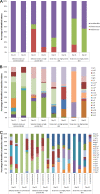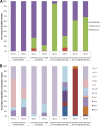Lactobacillus strain ecology and persistence within broiler chickens fed different diets: identification of persistent strains
- PMID: 20693442
- PMCID: PMC2950442
- DOI: 10.1128/AEM.01137-10
Lactobacillus strain ecology and persistence within broiler chickens fed different diets: identification of persistent strains
Abstract
Lactobacilli are autochthonous residents in the chicken gastrointestinal tract, where they may potentially be used as probiotics, competitive exclusion agents, or delivery vehicles. The aim of this study was to use an in vivo model to investigate the effect of diet and competing lactic acid bacteria on the colonization of inoculated Lactobacillus strains, with the goal of identifying strains which can consistently colonize or persist for an extended period of several weeks. Chicken-derived Lactobacillus strains were genetically marked with rifampin resistance and administered on day 0 to chickens fed either a normal commercial diet or a specially formulated high-protein diet. Chickens fed the high-protein diet were also coinoculated with two different mixes of additional lactic acid bacteria. Enterobacterial repetitive intergenic consensus sequence-based PCR (ERIC-PCR) was used to identify rifampin-resistant isolates recovered from chickens. Three strains, belonging to the species Lactobacillus agilis, Lactobacillus crispatus, and Lactobacillus vaginalis, were commonly reisolated from the chickens on both diets at days 21 and 42. The ability of these strains to persist was confirmed in a second chicken trial. All three strains persisted throughout the production period in the chickens fed a commercial diet, while only the L. agilis and L. vaginalis strains persisted in the chickens fed the high-protein diet. In both in vivo trials, competing lactic acid bacteria modified representation of the strains recovered, with all three stains capable of competing in the presence of one or both mixes of coinoculated strains. The in vivo model successfully identified three persistent strains that will be characterized further.
Figures



Similar articles
-
Transformation of, and heterologous protein expression in, Lactobacillus agilis and Lactobacillus vaginalis isolates from the chicken gastrointestinal tract.Appl Environ Microbiol. 2011 Jan;77(1):220-8. doi: 10.1128/AEM.02006-10. Epub 2010 Nov 12. Appl Environ Microbiol. 2011. PMID: 21075881 Free PMC article.
-
Discrimination of probiotic Lactobacillus strains for poultry by repetitive sequenced-based PCR fingerprinting.J Sci Food Agric. 2012 Feb;92(3):660-6. doi: 10.1002/jsfa.4627. Epub 2011 Sep 14. J Sci Food Agric. 2012. PMID: 21919004
-
Identification of the most abundant lactobacillus species in the crop of 1- and 5-week-old broiler chickens.Appl Environ Microbiol. 2007 Dec;73(24):7867-73. doi: 10.1128/AEM.01128-07. Epub 2007 Oct 12. Appl Environ Microbiol. 2007. PMID: 17933935 Free PMC article.
-
Molecular approaches for the detection and identification of bifidobacteria and lactobacilli in the human gastrointestinal tract.Syst Appl Microbiol. 2003 Nov;26(4):572-84. doi: 10.1078/072320203770865882. Syst Appl Microbiol. 2003. PMID: 14666986 Review.
-
Biodiversity of Intestinal Lactic Acid Bacteria in the Healthy Population.Adv Exp Med Biol. 2016;932:1-64. doi: 10.1007/5584_2016_3. Adv Exp Med Biol. 2016. PMID: 27167411 Review.
Cited by
-
Characterization of flagellins isolated from a highly motile strain of Lactobacillus agilis.BMC Microbiol. 2016 Mar 22;16:49. doi: 10.1186/s12866-016-0667-x. BMC Microbiol. 2016. PMID: 27001290 Free PMC article.
-
Stable Recombinant-Gene Expression from a Ligilactobacillus Live Bacterial Vector via Chromosomal Integration.Appl Environ Microbiol. 2021 May 11;87(11):e00392-21. doi: 10.1128/AEM.00392-21. Print 2021 May 11. Appl Environ Microbiol. 2021. PMID: 33741626 Free PMC article.
-
Potential of Lactobacillus plantarum IBB3036 and Lactobacillus salivarius IBB3154 to persistence in chicken after in ovo delivery.Microbiologyopen. 2019 Jan;8(1):e00620. doi: 10.1002/mbo3.620. Epub 2018 Mar 25. Microbiologyopen. 2019. PMID: 29575743 Free PMC article.
-
An Introduction to the Avian Gut Microbiota and the Effects of Yeast-Based Prebiotic-Type Compounds as Potential Feed Additives.Front Vet Sci. 2015 Sep 2;2:28. doi: 10.3389/fvets.2015.00028. eCollection 2015. Front Vet Sci. 2015. PMID: 26664957 Free PMC article. Review.
-
In Vitro Characterization of Probiotic Potential of Limosilactobacillus fermentum against Salmonella Gallinarum Causing Fowl Typhoid.Animals (Basel). 2023 Apr 8;13(8):1284. doi: 10.3390/ani13081284. Animals (Basel). 2023. PMID: 37106847 Free PMC article.
References
-
- Amit-Romach, E., D. Sklan, and Z. Uni. 2004. Microflora ecology of the chicken intestine using 16S ribosomal DNA primers. Poult. Sci. 83:1093-1098. - PubMed
-
- Apajalahti, J., A. Kettunen, and H. Graham. 2004. Characteristics of the gastrointestinal microbial communities, with special reference to the chicken. Worlds Poult. Sci. J. 60:223-232.
-
- Apajalahti, J. H. 2004. Structure and dietary modulation of intestinal microbial communities, p. 69-76. In Proceedings of the Second Mid-Atlantic Nutrition Conference. University of Maryland, College Park, MD.
-
- Barnes, E. M., G. C. Mead, and D. A. Barnum. 1972. The intestinal flora of the chicken in the period 2 to 6 weeks of age, with particular reference to the anaerobic bacteria. Br. Poult. Sci. 13:617-622. - PubMed
Publication types
MeSH terms
Substances
LinkOut - more resources
Full Text Sources
Other Literature Sources

